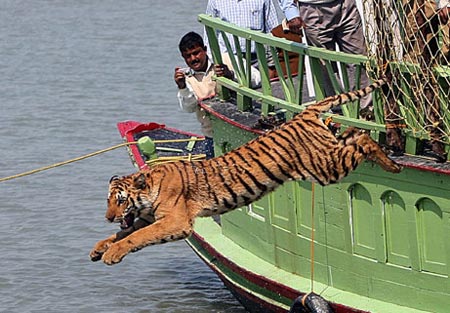Scary places for tigers
The largest animal in the cat family is facing extinction by demand for tiger products in China, Southeast Asian countries and the US.

A tiger in India.Photo: National Geographic .
According to AFP, environmental protection organizations regard the Year of the Tiger 2010 as an important time to convey the message of tigers. Russia is preparing a tiger conservation summit in September in Vladivostok.
Only about 3,200 tigers live in nature all over the world, of which nearly half are distributed in India. Only a century ago, the number of tigers is still around 100,000. But they are disappearing rapidly by the demand for bone, skin and other tiger products in China, Vietnam, and Laos. People use these products to cook high and make medicine.
But environmental protection organizations say the problem is not only in Asia. They also expressed concern for the United States - where more than 5,000 tigers are being kept in captivity for domestic scenes or for visitors in the zoo.
Crawford Allan, director of operations of Traffic in North America, said farm owners self-bred tigers to sell to people and zoos. This is the result of a recent survey conducted recently. Allan warned that some American restaurants sold tiger meat.
'America needs to act. Some states in the United States hardly know where the tigers are kept, how many children they have and whether they are trafficked, ' AFP quoted Allan.
Allan said that 26 states in the US banned tiger owners. But nine other states - including North Carolina, Ohio, South Carolina and Wisconsin - have not set any rules for capturing and trading this animal. Texas is the state with the largest number of tigers in the United States. The state government sets many rules for tiger ownership, but almost does nothing to enforce those regulations.
Conservation experts applauded China's efforts to stop tiger trade, but warned that the existence of private tiger farms in Asia is increasing their risk.
Chinese officials have announced that the country has nearly 6,000 tigers raised. Tiger farms can breed them to produce more than 1,000 new tigers. This is one of the measures to increase the number of tigers.
However, conservationists believe that many tigers are born in secret underground farms for illegal purposes.
'This is an extremely dangerous phenomenon for the survival of wild tigers. Once tiger farming becomes a business, it can stimulate and maintain demand for tiger products in the market , 'said Keshav Varma, Global Tiger Initiative project director of the World Bank. review
Varma said that the rise of the middle class in China and some other countries also made demand for tiger products soar. People want to buy them for cooking high, soaking wine, making medicine. Tiger skin can become a material to make luxurious gifts that people can give each other.
Huang Lixin, head of the University of Traditional Chinese Medicine in San Francisco, USA, said doctors should warn patients about the danger of the extinction of tigers and advise them not to use the parts tiger body.
'I think the tiger year is an extremely favorable opportunity to send a message of tiger conservation to Chinese public opinion and the Chinese community around the world , ' Lixin said.
- How are predatory tigers?
- The Lord of the Forest is around the world
- Legend of the tiger tiger U Minh
- The magnificent, magnificent tiger pictures of Siberia
- Fear for tigers in the year of tiger
- Four white tigers gave birth to four
- The United Nations is concerned about the survival of tigers
- Interesting: Goat raising tigers
- The number of tigers decreased rapidly
- Introducing the world's largest tiger and tiger
- Magical friendship between tigers and pigs
- The news that Tasmanian tigers became extinct 80 years ago appeared in Australia
 Is the magnetic North Pole shift dangerous to humanity?
Is the magnetic North Pole shift dangerous to humanity? Washington legalizes the recycling of human bodies into fertilizer
Washington legalizes the recycling of human bodies into fertilizer Lightning stone - the mysterious guest
Lightning stone - the mysterious guest Stunned by the mysterious sunset, strange appearance
Stunned by the mysterious sunset, strange appearance